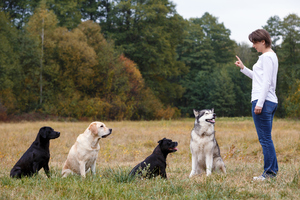Do our pets understand us?

Petplan takes a lot at just how much our pets can understand us, examining past scientific studies and new methods that can help your pet to understand you…
Clever dogs
Whilst your dog might understand your basic cues including reading your mood and knowing when you need a hug, here are some of the cleverest dogs on the planet and their greatest achievements:
Rico: A Border Collie from Germany
In 2004, scientists proved that Rico the Border Collie could understand more than 200 verbal cues. They also found that Rico could identify familiar objects at an average of 37 times out of 40, and could respond correctly to unfamiliar words used to identify objects he had never seen before.
Sian Ryan, an animal behavioural consultant, commented on Rico’s behaviour: ‘This could be explained by a dog’s natural interest in new things, or by process of deduction – "I know the noises for all the other things in this room so the one I don’t know must be the one they want."
Chaser: A Border Collie from South Carolina
In 2010, Chaser, another Border Collie from South Carolina went above and beyond. With the help of her owner, she learned more than 1000 words!
Sofia: A Crossbreed from Brazil
In 2012 Sofia proved that she can ask for what she wants by pressing keys on an electronic panel that correspond to "toy", "food", "walk" and so on. Despite the fact she was of no particular breed of dog, she showed incredible understanding the likes of which is uncommon even in breeds renowned for their intelligence.
How to improve your dog’s understanding
Dogs love to observe us, and they really are a man’s best friend! It’s their desire to cooperate with humans which makes them such great learners of visual and verbal cues.
But how should you go about improving your own dog’s language skills?
- Classical conditioning - Say the word immediately before the dog performs the action so that the word becomes a predictor for the action.
- Use visual signals - Dogs pick up visual signals faster than verbal ones, so try to associate a hand movement with a certain behaviour and cue word, e.g. ‘Sit’.
- Repetition – Repeat the hand movement and cue word until your pooch has it perfected!
- Reward - All dogs love food, so what better way to reward your dog’s newly-found language skills than with a tasty treat or two. Just remember not to feed your dog more than the recommended amount and healthy treats are always a good alternative!
But to develop an even more impressive vocabulary, the most important thing to do is regularly talk to your dog.
Sian suggests that you should ‘Use phrases such as "Do you want to go outside?" as you open the back door, and "Time to go for a walk" as you pick up the lead’ - your dog will soon learn what those words mean.
What about cats?
Contrary to popular belief, cats can learn new tricks! However, most cat owners will admit that while their moggies often do demonstrate understanding of verbal cues, they can’t always be relied upon to respond!
This is the major difference between cats and dogs, and may be because dogs have been bred to work alongside humans. They need to be able to understand and carry out commands, whereas cats have always been far more independent.
Studies have shown that cats can easily distinguish the sound of their owner's voice from strangers’ voices – but this doesn’t mean they are paying attention to what is being said! In fact, cats are far more likely to develop selective deafness and ignore us altogether.
Whether our pets can understand us or not, it’s our responsibility as pet owners to ensure we do all we can to help and protect our furry friends. Ensure you have Petplan’s pet insurance to cover any unexpected veterinary treatment should your pet fall ill or suffer an injury!
Do you think your pet can understand you? Tell us about your experiences in the comments below.

